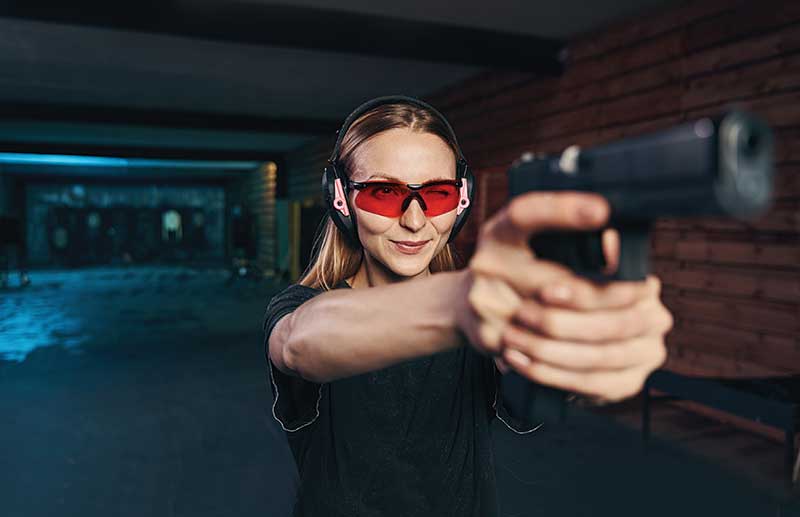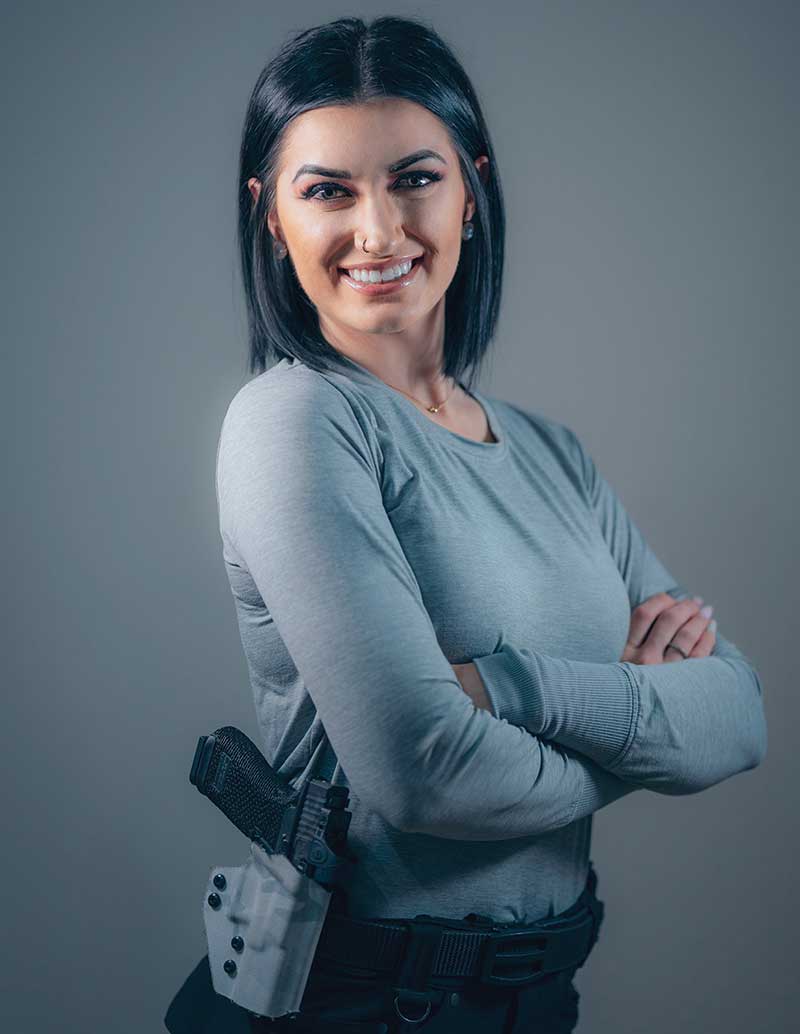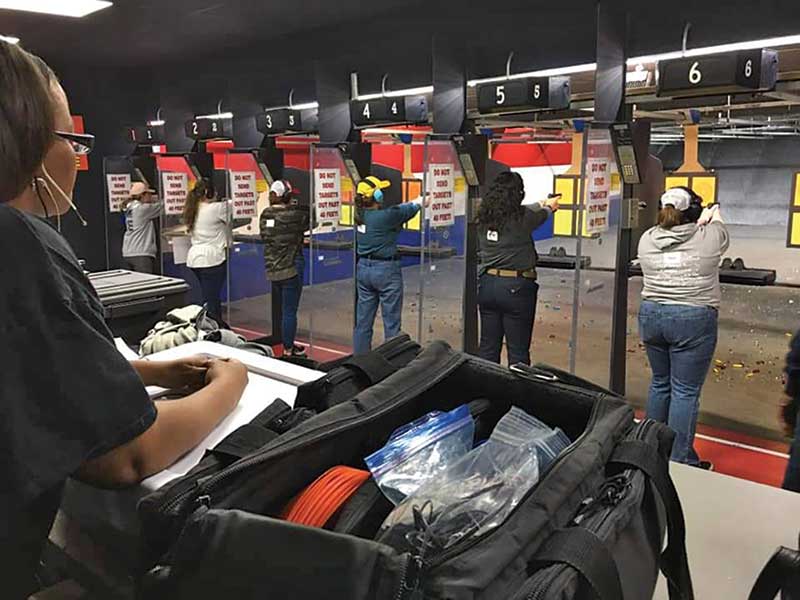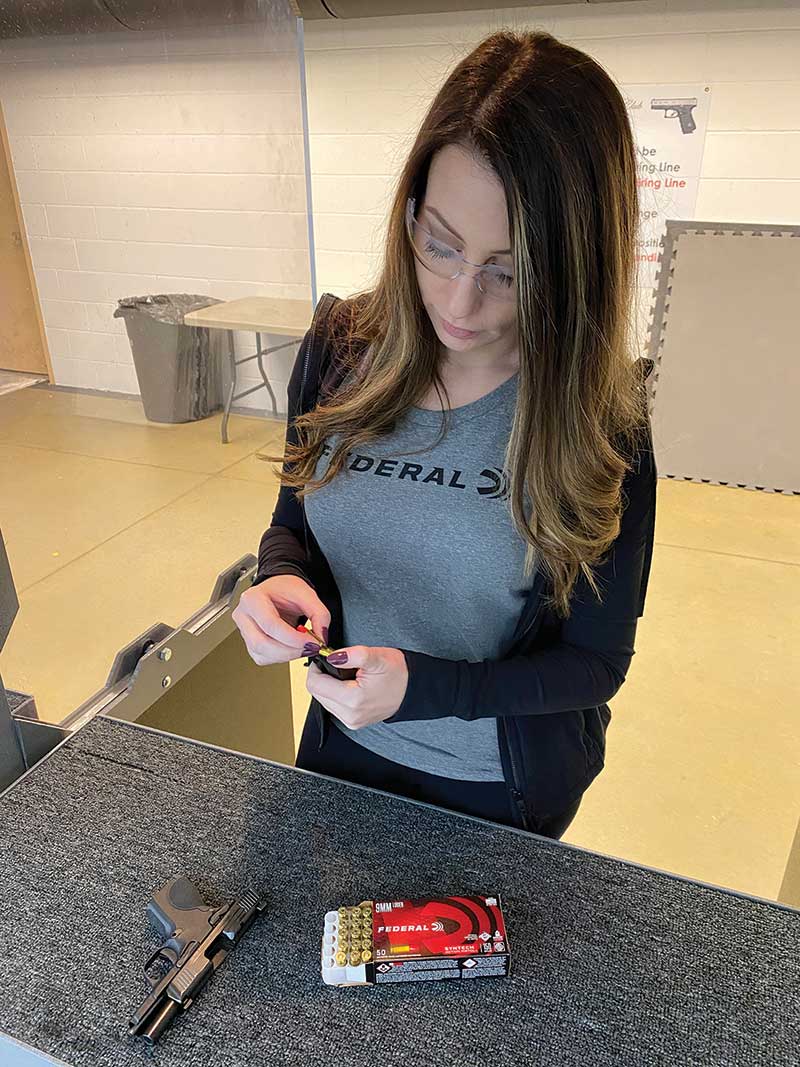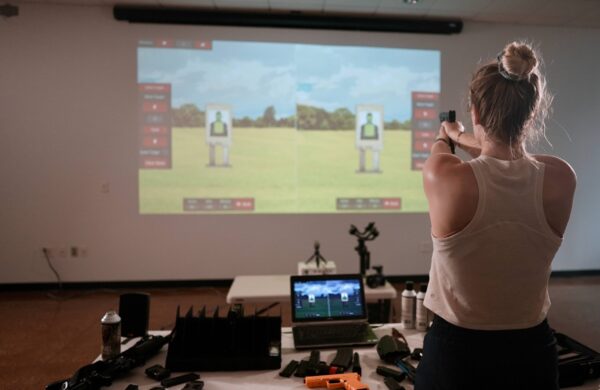Training Today
Instructors & Programs Adapt
To Changing Times
The past couple of years have been a wild ride for gun stores and shooting ranges. Historic firearms and ammunition sales, unprecedented shortages, a crippled supply chain, as well as mandates and lockdowns that required dealers and range operators to improvise and adapt on the fly.
During this period, more than 13.5 million people purchased a firearm for the first time, according to the NSSF. Many of those new gun owners lined up at ranges across the country to train. To this day, traffic at shooting ranges remains strong.
“A person’s first impression when shooting a firearm often determines their long-term relationship with guns.”
Paige Roux
Exactly how did shooting ranges navigate the turbulence of the past two years? How were instructors and range operators able to work around the ammo shortage? In what ways did training programs change in order to meet the needs of so many new gun owners while continuing to serve experienced shooters? What does the future of firearms training look like?
To answer these questions and more, SI spoke with Ava Flanell, owner of Elite Firearms & Training in Colorado Springs, Colo.; Tiffany Johnson, an NRA training counselor and instructor at Citizens Safety Academy in Murfreesboro, Tenn.; Lisa Roux, owner and CFO of Shooter’s World; and Paige Roux, training coordinator and senior firearms instructor at Shooter’s World in Arizona. (Editor’s Note: The quotes attributed to Lisa and Paige Roux are presented together.)
SI: How long have you been offering firearms training?
Johnson: About 20 years.
Flanell: I’ve been an NRA Certified Instructor since 2013, and I’ve also owned Elite Firearms & Training since then, as well.
Roux: Shooter’s World has been offering training in the Phoenix area since 1989.
SI: How have your training approaches and offerings evolved over the years?
Roux: We’ve evolved our class offerings to appeal to different demographics and customer needs. This includes classes specifically for women — the fastest-growing demographic in the gun industry over the past five years, youth classes and a new curriculum we developed called Defensive Mindset.
This non-shooting class focuses on situational awareness and the use of various self-defense tools for customers or situations where a firearm isn’t the best option. Many concerned parents have taken this class with their teens to help them navigate living in a time with unprecedented distractions. We partner with parents to help reinforce critical skills for teens and adults, such as the importance of being aware of your surroundings and carrying yourself confidently.
“When you get a new class, you must start with a clean palette and assume they know nothing.”
Ava Flanell
Flanell: I’ve evolved as an instructor. I’m always a student taking opportunities to learn anything I can so I can pass new knowledge on to my students. In my opinion, my classes continue to get better. What’s changed the most is how long they are. Over the years, I’ve discovered better techniques to explain and demonstrate the class material. I would say I’ve become more efficient so students don’t feel like the class is filled with fluff or repetitive information. It maintains their attention and interest.
Johnson: I used to be against ladies-only training. Now I see it as a legitimate approach to student-centered instruction, as long as the instructor doesn’t water down the material and gives the same substantive content to ladies-only classes as they do to coed classes.
SI: What’s your secret to firearms training success?
Flanell: There’s a lot of firearms instructors out there, but very few teachers. This sounds so cheesy, but when you get a new class, you must start with a clean palette and assume they know nothing. You have to put yourself in the student’s position by starting with the fundamentals and building up to more advanced topics.
Additionally, you must be approachable. Firearms is an intimidating topic, and when you’re in a class environment, you’re even more likely to hold back from asking questions. Make the class fun, add some humor and get the students to open up to one another so it creates a more relaxed environment for learning. Students who enjoy their experience will let their friends and family know. Word of mouth is the best form of advertisement.
Johnson: Patience, honesty and creativity. Remaining student-centered — always striving to see my students’ points of view and remove my own ego from the equation.
Roux: A person’s first impression when shooting a firearm often determines their long-term relationship with guns. We hire and train our instructors to provide a safe, non-intimidating, customer service-oriented experience. We recognize the need for instructors who are patient, understanding, approachable and who will leave the student empowered to continue to train and learn.
SI: Did the ammunition shortage over the past couple of years affect your training efforts? How so?
Johnson: Not as much as other training schools. Since we focus on beginner shooters, our classes are shorter and have lower round counts. It worked to our benefit during the ammo shortage.
Roux: Yes, our training efforts were impacted by the increased cost in ammunition. During the ammo shortage, we reduced the required round count in many classes without impacting the level of training by using additional tools such as dry-fire practice. We’ve always emphasized the importance of quality of rounds over quantity.
Flanell: So many instructors think a good class means firing hundreds of rounds. From day one, I’ve always made sure each shot counts. A good instructor can teach a student how to properly shoot well with less than 50 rounds of ammunition. Maintaining those skills after class is, of course, something up to the student, to which I encourage dry-firing techniques and training aids.
“High-quality instruction and a student- centered approach raises the odds of repeat customers.”
Tiffany Johnson
SI: What did you do to overcome the ammo challenges?
Roux: As a company, we decided the continuity of ammo supply for our customers was the most critical factor during the shortage. We were forced to pay far above retail for much of the ammo we procured during that time, but doing so allowed us to maintain a steady supply. We also continued to offer ammo discounts for students, gun-purchase customers and our members.
Flanell: In many classes, I utilized airguns, laser guns and dry-firing. In 2020, classes were booked out for months. Even if ammo wasn’t available or in short supply, students still wanted to learn how to operate their guns and get a concealed carry permit, regardless of range time being an option. When something becomes unavailable you must find a close alternative.
Although I don’t think anything on the market can replicate live-fire, I felt confident I equipped students with the knowledge of how to use their firearm. For those students who had the opportunity to shoot, I made sure we used very little ammo. I substituted ammo with snap caps so students could work on their trigger pull and anticipation as well as learn how to clear a malfunction.
SI: How has the nationwide influx of first-time gun owners affected your training program?
Roux: We’ve offered additional class dates and times, added additional jobs to our local economy with the addition of more instructors. We also added RSOs due to the number of first-time shooters who were taking our classes. As a responsible firearms retailer with a heavy emphasis on safe firearms handling and ownership, we strongly encouraged those looking to purchase their first firearm to demo our range rentals prior to making a purchasing decision. Part of our business model has always been to offer discounts for training classes and free range passes with every firearm purchase to encourage customers to become proficient with their gun.
Our overall inventory and purchasing strategy was also impacted by this influx. We heavily purchased guns that are popular for first-time gun owners and quickly became known for consistently having the inventory for these customers.
Flanell: I would say the influx has died down a bit. Classes were selling out left and right and now things have returned to a normal pace. One thing I noticed during this time was the types of people taking classes. I saw a huge influx of people who lean left politically or used to be anti-gun attending classes. Students seemed to be more emotionally pulled to take the class based on current events and it made for interesting discussions in class.
Johnson: We welcome it, since it’s our focal point. It’s increased the size of our target market and opened up lots of business-development opportunities both for in-person training and for online training.
SI: How are you continuing to appeal to your established customers and experienced shooters?
Roux: We continue to offer training for intermediate-level shooters in our class offerings. More advanced shooters continue to benefit from taking private, fully customizable lessons with our most experienced instructors. We also offer special events with local manufacturers to provide unique opportunities to interact with new products.
Flanell: Now that things have calmed down a bit, I plan to add more advanced classes to the calendar. I have all these new gun owners who took the basic classes and are looking to advance their skills.
Johnson: High-quality instruction and a student-centered approach raises the odds of repeat customers.
SI: What does the future of firearms training look like? Are you expecting growth?
Roux: We’ll continue to reach out and engage with new gun owners through targeted marketing efforts. We’re expecting additional growth and many more new gun owners over the next 18–24 months. In fact, our third indoor range is currently under construction in Goodyear, Ariz.
Unfortunately, the firearms industry is heavily impacted by current events, which oftentimes means unexpected changes in business. With the current instability both domestically and abroad, we anticipate this leading to additional demand for firearms and ammunition. Due to the volatility of the industry, we work every day to be prepared for these unknowns.
Flanell: Anyone who has been in the firearms industry for some time knows about the peaks and valleys. Unfortunately, we tend to see the peaks when unfortunate events happen that breed fear. Personally, I’ve seen a slight decline in business the past two months. This happens from time to time, which just means instructors must get creative and create classes or events to pique the interest of their current customers. I have invested in a virtual training simulator and it allows for incorporating movement and cover drills most ranges aren’t equipped to allow safely. Adding advanced training in a 100% safe environment like this is a big opportunity to teach valuable skills many people won’t be able to practice otherwise.
Johnson: We expect tremendous growth, and we’re already seeing it happen. We look forward to welcoming as many newcomers as possible. The more we dispel the outdated stereotypes of gun ownership, the faster our community will expand.
SI: Any advice you would offer to dealers or ranges looking to revamp or expand their training programs?
Johnson: Get out of the box. Don’t focus on being “gun people.” Instead, be regular folks who also just coincidentally happen to own and carry guns. It makes you more relatable to customers and students, especially those who are new to the firearms community.
Roux: Offer packages that encourage students to continue their firearms training journey with you. Create a warm, welcoming and safe environment where everyone feels a sense of belonging. Continue to network with industry trainers to expand or update your personal knowledge in order to make decisions about what to add to your curriculum. Keep your knowledge and skills up to date!
Flanell: Nothing lasts forever. Take advantage of the busy times and enjoy the small breaks in between to reflect and find new opportunities to expand your business.

